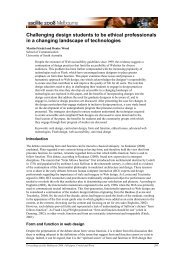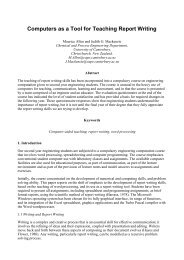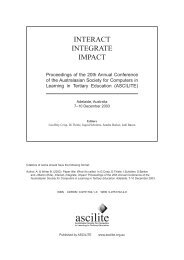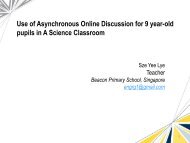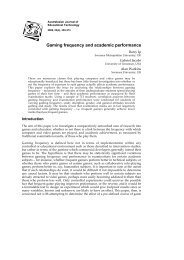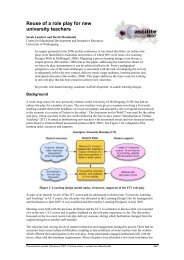Authentic assessment strategies in problem based learning - ascilite
Authentic assessment strategies in problem based learning - ascilite
Authentic assessment strategies in problem based learning - ascilite
You also want an ePaper? Increase the reach of your titles
YUMPU automatically turns print PDFs into web optimized ePapers that Google loves.
to solve complex <strong>problem</strong>s. Portfolio Assessment <strong>in</strong>volves develop<strong>in</strong>g a portfolio that documents learn<strong>in</strong>g<br />
over time which <strong>in</strong> this study <strong>in</strong>clude and not limited to: journal entries; peer reviews; artwork, diagrams,<br />
charts, graphs; multimedia presentation; group reports; student notes and outl<strong>in</strong>es; rough drafts and<br />
polished writ<strong>in</strong>g (Hart, 1994; Ward & Lee, 2002). Reflection and Self-Assessment requires students<br />
reflect and evaluate their own participation, learn<strong>in</strong>g progress, and products which are essential<br />
component of autonomous learn<strong>in</strong>g (Hart, 1994).<br />
Table 1: Herr<strong>in</strong>gton and Herr<strong>in</strong>gton’s (1998) essential elements of authentic <strong>assessment</strong><br />
Categories Criteria<br />
Context Requires fidelity of context to reflect the conditions under which the<br />
performance will occur<br />
(rather than contrived, artificial or de-contextualised conditions)<br />
Student’s role Requires students to be effective performers with acquired knowledge, and to<br />
craft polished,<br />
performances or products<br />
Requires significant student time and effort <strong>in</strong> collaboration with others<br />
<strong>Authentic</strong> activity Involves complex, ill structured challenges that require judgments, and a full<br />
array of tasks<br />
Requires the <strong>assessment</strong> to be seamlessly <strong>in</strong>tegrated with the activity<br />
Indicators Provides multiple <strong>in</strong>dicators of learn<strong>in</strong>g<br />
Achieves validity and reliability with appropriate criteria for scor<strong>in</strong>g varied<br />
products<br />
Design<strong>in</strong>g an authentic <strong>assessment</strong> strategy<br />
Glasgow (1996) categorizes <strong>assessment</strong> <strong>strategies</strong> <strong>in</strong>to three areas of content, process, and outcome.<br />
Content deals with the knowledge students acquire, while process focuses on the students’ ability to apply<br />
knowledge and skill <strong>in</strong> <strong>problem</strong>-solv<strong>in</strong>g. Outcome <strong>assessment</strong>s whereas <strong>in</strong>volve the products students<br />
design that shows their comb<strong>in</strong>ation of content and new applications of knowledge, <strong>in</strong> this case the<br />
creation of a multimedia application.<br />
The issue raised from PBL is to provide an authentic <strong>assessment</strong> strategy. This learn<strong>in</strong>g space requires<br />
support <strong>in</strong> collaboration and communication among the students as a medium to exchange ideas, conduct<br />
discussion and put hands together. Students research, document, do peer’s feedback, design, learn various<br />
author<strong>in</strong>g tools for acquir<strong>in</strong>g, manipulat<strong>in</strong>g, and communicat<strong>in</strong>g <strong>in</strong>formation <strong>in</strong> order to solve the<br />
<strong>problem</strong>s and challenges given to them.<br />
The scope of the study was conf<strong>in</strong>ed to 53 students (N=53) tak<strong>in</strong>g Interactive Multimedia course, from<br />
Multimedia University. These students were not equipped with design and multimedia knowledge as they<br />
came from management or <strong>in</strong>formation technology background. Content <strong>assessment</strong> (consists of pretest<br />
and posttest) were conducted to p<strong>in</strong> po<strong>in</strong>t the students’ knowledge ga<strong>in</strong> <strong>in</strong> design and multimedia theories.<br />
A total of 10% is given to both tests (5% to each test).<br />
Students then formed 11 teams (T1-T11) of four or five members (TM) of their desired choice. A Team<br />
Leader (TL) was elected from every team. Each team was to output a PC-<strong>based</strong> multimedia application<br />
demonstrat<strong>in</strong>g understand<strong>in</strong>g and apply<strong>in</strong>g knowledge of design theories and techniques learnt <strong>in</strong> the<br />
lectures with the theme “Malaysian Culture” with<strong>in</strong> a 14-week time frame. The content of the application<br />
was entirely the team’s decision. At this stage, the <strong>in</strong>structors clearly def<strong>in</strong>e the standards and<br />
expectations of the application outcome and briefed the students of the criteria <strong>in</strong> assess<strong>in</strong>g students’<br />
work. Throughout the <strong>assessment</strong> process, students were rem<strong>in</strong>ded aga<strong>in</strong> on the <strong>assessment</strong> criteria so not<br />
to lose focus. <strong>Authentic</strong> <strong>assessment</strong> is most successful when students know what the <strong>in</strong>structors expect.<br />
(Pearson Education Development Group, 2007)<br />
The challenges beh<strong>in</strong>d this project was not limited to deal with team members who have multiple<br />
abilities, varied learn<strong>in</strong>g styles, and diverse backgrounds, but also <strong>problem</strong> solv<strong>in</strong>g <strong>strategies</strong> at different<br />
stages of the design. The maximum project grade (60%) goes to f<strong>in</strong>al portfolio <strong>assessment</strong> base on the<br />
criteria set by the facilitator which <strong>in</strong>clude the delivery of the f<strong>in</strong>al work, functionality and <strong>in</strong>teractivity of<br />
the application, enterta<strong>in</strong>ment value, presentation skills and f<strong>in</strong>al submissions. This portfolio <strong>assessment</strong><br />
made way <strong>in</strong> determ<strong>in</strong><strong>in</strong>g the PBL outcomes.<br />
Proceed<strong>in</strong>gs <strong>ascilite</strong> S<strong>in</strong>gapore 2007: Full paper: Tai and Yuen 984



